Multiscale Analysis of Functional Surfaces Produced by L-PBF Additive Technology and Titanium Powder Ti6Al4V
Abstract
1. Introduction
2. Materials and Methods
3. Results
4. Discussion
5. Conclusions
- It is possible to manufacture precise models with characteristic morphological features of various sizes and shapes using additive technologies. Based on the scanning electron microscope and computed tomography analysis, it can be noted that there are no defects caused by the technological process and no unmelted powder grains on the tested surfaces. The production of surfaces with a much more complicated shape should not be problematic for additive technologies compared to the limitations known for conventional technologies such as machining. The research has shown that it is a clear advantage compared to conventional methods, where shaping such irregularities and defined morphological features on the surface is hindered or sometimes impossible.
- It cannot be clearly concluded whether the application of more surface modelling functions resulted in better or worse mapping of the model surface. In the case of surfaces described by a single function (compared approximation function and measured profile), the differences in the parameters differed relatively by an average of approximately twenty percent in terms of the amplitude and several percent in terms of the period, for a matching value of 0.7–0.85, depending on the profile, which means a correlation dependence according to J.P. Guildford’s classification. In the case of a surface defined by several periodic functions, these parameters differed by thirty and several percent, respectively, which for a matching of more than 0.95 proves a very clear correlation dependence. Moreover, comparing the profile specified in the CAD model with the profile of the approximating function, there are differences in the accuracy of the fit depending on the printing direction of the sample models. The most favorable variant due to amplitude and periodic differences is to place the models at the smallest possible angle to the building platform: for the assessed samples, it was an angle equal to 20°. In this case, the amplitude differences reached only a few micrometers. A reduction in the surface irregularities mapping quality was observed with increasing building angle (printing direction), which has a negative effect on the building time, layer number, and stair-step effect.
- When analysing the data obtained through wavelet filtration, it can be concluded that the dominant error component was high-frequency information resulting from production process errors and corresponding to surface pores. An assessment of the resulting signals leads to a conclusion that signals from the sixth level upwards do not contain such information.
- In the case of mother wavelets with a large support, the obtained profile-matching coefficients, as well as the approximating function period and amplitude values, were better. However, they slightly decreased when support increased. This tendency could be observed up to the sixth decomposition level. Unnatural distortion of the resulting signals was observed at further levels.
- The research showed that wavelet transformation can be successfully applied as a diagnostic tool in surface texture assessment and used as a base to diagnose the production process. It seems that a significant limitation of the technological process is that the layer thickness is determined, among other things, by the size of the powder grains, and in future research, it will be possible to analyse much more precisely manufactured models using multiscale analysis.
Author Contributions
Funding
Institutional Review Board Statement
Informed Consent Statement
Data Availability Statement
Conflicts of Interest
References
- Snopiński, P.; Król, M.; Pagáč, M.; Petrů, J.; Hajnyš, J.; Mikuszewski, T.; Tański, T. Effects of equal channel angular pressing and heat treatments on the microstructures and mechanical properties of selective laser melted and cast AlSi10Mg alloys. Arch. Civ. Mech. Eng. 2021, 21, 92. [Google Scholar] [CrossRef]
- Piekło, J.; Garbacz-Klempka, A. Use of selective laser melting (SLM) as a replacement for pressure die casting technology for the production of automotive casting. Arch. Foundry Eng. 2021, 21, 9–16. [Google Scholar]
- Budzik, G.; Przeszlowski, L.; Wieczorowski, M.; Rzucidlo, A.; Gapinski, B.; Krolczyk, G. Analysis of 3D printing parameters of gears for hybrid manufacturing. AIP Conf. Proc. 2018, 1960, 140005. [Google Scholar]
- Diaz, A. Surface texture characterization and optimization of metal additive manufacturing-produced components for aerospace applications. In Additive Manufacturing for the Aerospace Industry; Elsevier: Amsterdam, The Netherlands, 2019; pp. 341–374. [Google Scholar] [CrossRef]
- Wang, Y.; Peng, T.; Zhu, Y.; Yang, Y.; Tang, R. A comparative life cycle assessment of a selective-laser-melting-produced hydraulic valve body using design for Property. Procedia CIRP 2020, 90, 220–225. [Google Scholar] [CrossRef]
- Edelmann, A.; Dubis, M.; Hellmann, R. Selective laser melting of patient individualized osteosynthesis plates—Digital to physical process chain. Materials 2020, 13, 5786. [Google Scholar] [CrossRef]
- Gogolewski, D.; Kozior, T.; Zmarzły, P.; Mathia, T.G. Morphology of Models Manufactured by SLM Technology and the Ti6Al4V Titanium Alloy Designed for Medical Applications. Materials 2021, 14, 6249. [Google Scholar] [CrossRef]
- Triantaphyllou, A.; Giusca, C.L.; Macaulay, G.D.; Roerig, F.; Hoebel, M.; Leach, R.K.; Tomita, B.; Milne, K.A. Surface texture measurement for additive manufacturing. Surf. Topogr. Metrol. Prop. 2015, 3, 024002. [Google Scholar] [CrossRef]
- Qian, W.; Wu, S.; Wu, Z.; Ahmed, S.; Zhang, W.; Qian, G.; Withers, P.J. In situ X-ray imaging of fatigue crack growth from multiple defects in additively manufactured AlSi10Mg alloy. Int. J. Fatigue 2022, 155, 106616. [Google Scholar] [CrossRef]
- Hu, Y.N.; Wu, S.C.; Wu, Z.K.; Zhong, X.L.; Ahmed, S.; Karabal, S.; Xiao, X.H.; Zhang, H.O.; Withers, P.J. A new approach to correlate the defect population with the fatigue life of selective laser melted Ti-6Al-4V alloy. Int. J. Fatigue 2020, 136, 105584. [Google Scholar] [CrossRef]
- Khaemba, D.N.; Azam, A.; See, T.L.; Neville, A.; Salehi, F.M. Understanding the role of surface textures in improving the performance of boundary additives, part I: Experimental. Tribol. Int. 2020, 146, 106243. [Google Scholar] [CrossRef]
- Zmarzły, P. Multi-dimensional mathematical wear models of vibration generated by rolling ball bearings made of aisi 52100 bearing steel. Materials 2020, 13, 5440. [Google Scholar] [CrossRef]
- Gogolewski, D. Multiscale assessment of additively manufactured free-form surfaces. Metrol. Meas. Syst. 2023, 30. [Google Scholar] [CrossRef]
- Pagani, L.; Townsend, A.; Zeng, W.; Lou, S.; Blunt, L.; Jiang, X.Q.; Scott, P.J. Towards a new definition of areal surface texture parameters on freeform surface: Re-entrant features and functional parameters. Meas. J. Int. Meas. Confed. 2019, 141, 442–459. [Google Scholar] [CrossRef]
- Podulka, P. Thresholding Methods for Reduction in Data Processing Errors in the Laser-Textured Surface Topography Measurements. Materials 2022, 15, 5137. [Google Scholar] [CrossRef]
- Townsend, A.; Senin, N.; Blunt, L.; Leach, R.K.; Taylor, J.S. Surface texture metrology for metal additive manufacturing: A review. Precis. Eng. 2016, 46, 34–47. [Google Scholar] [CrossRef]
- Gogolewski, D.; Zmarzły, P.; Kozior, T.; Mathia, T.G. Possibilities of a Hybrid Method for a Time-Scale-Frequency Analysis in the Aspect of Identifying Surface Topography Irregularities. Materials 2023, 16, 1228. [Google Scholar] [CrossRef] [PubMed]
- Prabhakar, D.V.N.; Sreenivasa Kumar, M.; Gopala Krishna, A. A Novel Hybrid Transform approach with integration of Fast Fourier, Discrete Wavelet and Discrete Shearlet Transforms for prediction of surface roughness on machined surfaces. Meas. J. Int. Meas. Confed. 2020, 164, 108011. [Google Scholar] [CrossRef]
- Brown, C.A.; Hansen, H.N.; Jiang, X.J.; Blateyron, F.; Berglund, J.; Senin, N.; Bartkowiak, T.; Dixon, B.; Le Goïc, G.; Quinsat, Y.; et al. Multiscale analyses and characterizations of surface topographies. CIRP Ann. 2018, 67, 839–862. [Google Scholar] [CrossRef]
- Zare, M.; Solaymani, S.; Shafiekhani, A.; Kulesza, S.; Ţǎlu, Ş.; Bramowicz, M. Evolution of rough-surface geometry and crystalline structures of aligned TiO2 nanotubes for photoelectrochemical water splitting. Sci. Rep. 2018, 8, 10870. [Google Scholar] [CrossRef]
- Bartkowiak, T.; Brown, C.A. Multiscale 3D curvature analysis of processed surface textures of aluminum alloy 6061 T6. Materials 2019, 12, 257. [Google Scholar] [CrossRef] [PubMed]
- Maleki, I.; Wolski, M.; Woloszynski, T.; Podsiadlo, P.; Stachowiak, G. A comparison of multiscale surface curvature characterization methods for tribological surfaces. Tribol. Online 2019, 14, 8–17. [Google Scholar] [CrossRef]
- Li, G.; Zhang, K.; Gong, J.; Jin, X. Calculation method for fractal characteristics of machining topography surface based on wavelet transform. Procedia CIRP 2019, 79, 500–504. [Google Scholar] [CrossRef]
- Sun, J.; Song, Z.; He, G.; Sang, Y. An improved signal determination method on machined surface topography. Precis. Eng. 2018, 51, 338–347. [Google Scholar] [CrossRef]
- Gogolewski, D. Fractional spline wavelets within the surface texture analysis. Meas. J. Int. Meas. Confed. 2021, 179, 109435. [Google Scholar] [CrossRef]
- Pahuja, R.; Ramulu, M. Study of surface topography in Abrasive Water Jet machining of carbon foam and morphological characterization using Discrete Wavelet Transform. J. Mater. Process. Technol. 2019, 273, 116249. [Google Scholar] [CrossRef]
- Abdul-Rahman, H.S.; Jiang, X.J.; Scott, P.J. Freeform surface filtering using the lifting wavelet transform. Precis. Eng. 2013, 37, 187–202. [Google Scholar] [CrossRef]
- Yesilli, M.C.; Chen, J.; Khasawneh, F.A.; Guo, Y. Automated surface texture analysis via Discrete Cosine Transform and Discrete Wavelet Transform. Precis. Eng. 2022, 77, 141–152. [Google Scholar] [CrossRef]
- Gogolewski, D. Influence of the edge effect on the wavelet analysis process. Meas. J. Int. Meas. Confed. 2020, 152, 107314. [Google Scholar] [CrossRef]
- Navarro, P.J.; Fernández-Isla, C.; Alcover, P.M.; Suardíaz, J. Defect detection in textures through the use of entropy as a means for automatically selecting the wavelet decomposition level. Sensors 2016, 16, 1178. [Google Scholar] [CrossRef]
- Bruzzone, A.A.G.; Montanaro, J.S.; Ferrando, A.; Lonardo, P.M. Wavelet analysis for surface characterisation: An experimental assessment. CIRP Ann. Manuf. Technol. 2004, 53, 479–482. [Google Scholar] [CrossRef]
- Gogolewski, D.; Makieła, W.; Nowakowski, Ł. An assessment of applicability of the two-dimensionalwavelet transform to assess the minimum chip thickness determination accuracy. Metrol. Meas. Syst. 2020, 27, 659–672. [Google Scholar]
- Dutta, S.; Pal, S.K.; Sen, R. Progressive tool flank wear monitoring by applying discrete wavelet transform on turned surface images. Meas. J. Int. Meas. Confed. 2016, 17, 388–401. [Google Scholar] [CrossRef]
- Nouhi, S.; Pour, M. Prediction of surface roughness of various machining processes by a hybrid algorithm including time series analysis, wavelet transform and multi view embedding. Meas. J. Int. Meas. Confed. 2021, 184, 109904. [Google Scholar] [CrossRef]
- Shao, Y.; Du, S.; Tang, H. An extended bi-dimensional empirical wavelet transform based filtering approach for engineering surface separation using high definition metrology. Meas. J. Int. Meas. Confed. 2021, 178, 109259. [Google Scholar] [CrossRef]
- Mahashar Ali, J.; Siddhi Jailani, H.; Murugan, M. Surface roughness evaluation of electrical discharge machined surfaces using wavelet transform of speckle line images. Meas. J. Int. Meas. Confed. 2020, 149, 107029. [Google Scholar] [CrossRef]
- Ti64 M290 Material Data Sheet. Available online: https://3dformtech.fi/wp-content/uploads/2019/11/Ti-Ti64_9011-0014_9011-0039_M290_Material_data_sheet_11-17_en-1.pdf (accessed on 28 March 2023).
- Todhunter, L.D.; Leach, R.K.; Lawes, S.D.A.; Blateyron, F. Industrial survey of ISO surface texture parameters. CIRP J. Manuf. Sci. Technol. 2017, 19, 84–92. [Google Scholar] [CrossRef]
- Leach, R.; Thompson, A.; Senin, N.; Maskery, I. A metrology horror story: The additive surface. In Proceedings of the ASPEN/ASPE Spring Topical Meeting on Manufacture and Metrology of Structured and Freeform Surfaces for Functional Applications, Hong Kong, China, 14–17 March 2017. [Google Scholar]

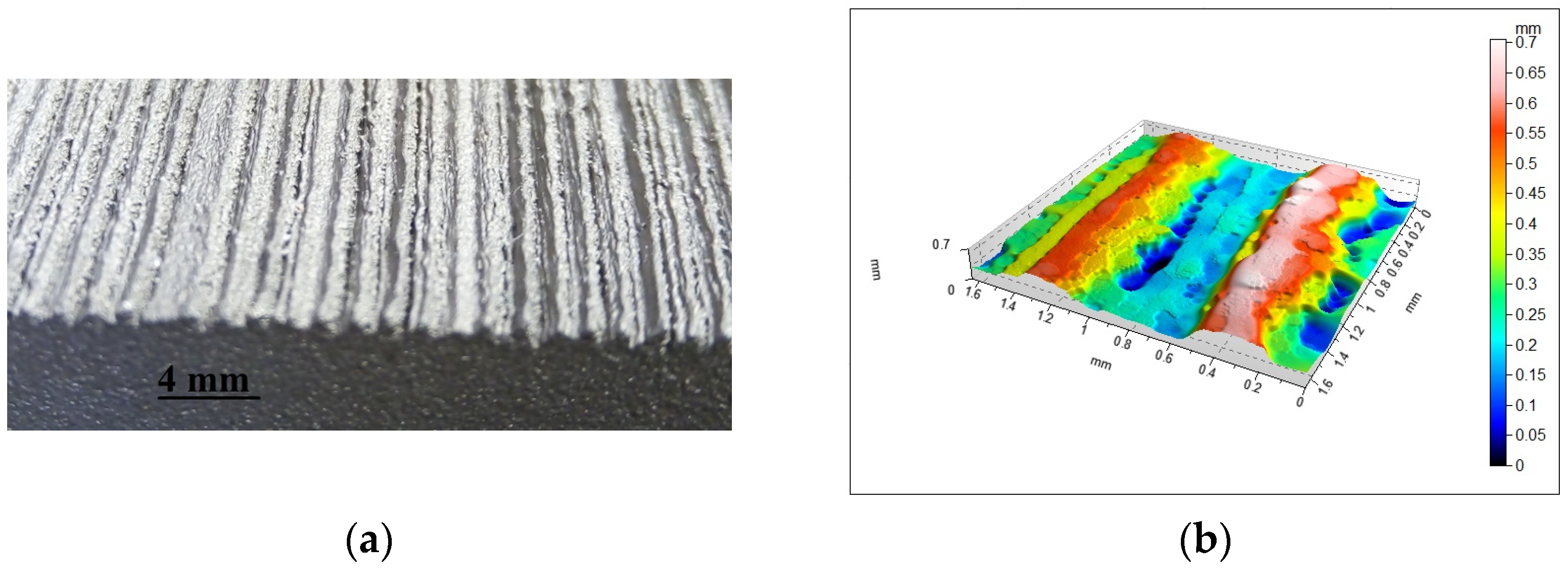

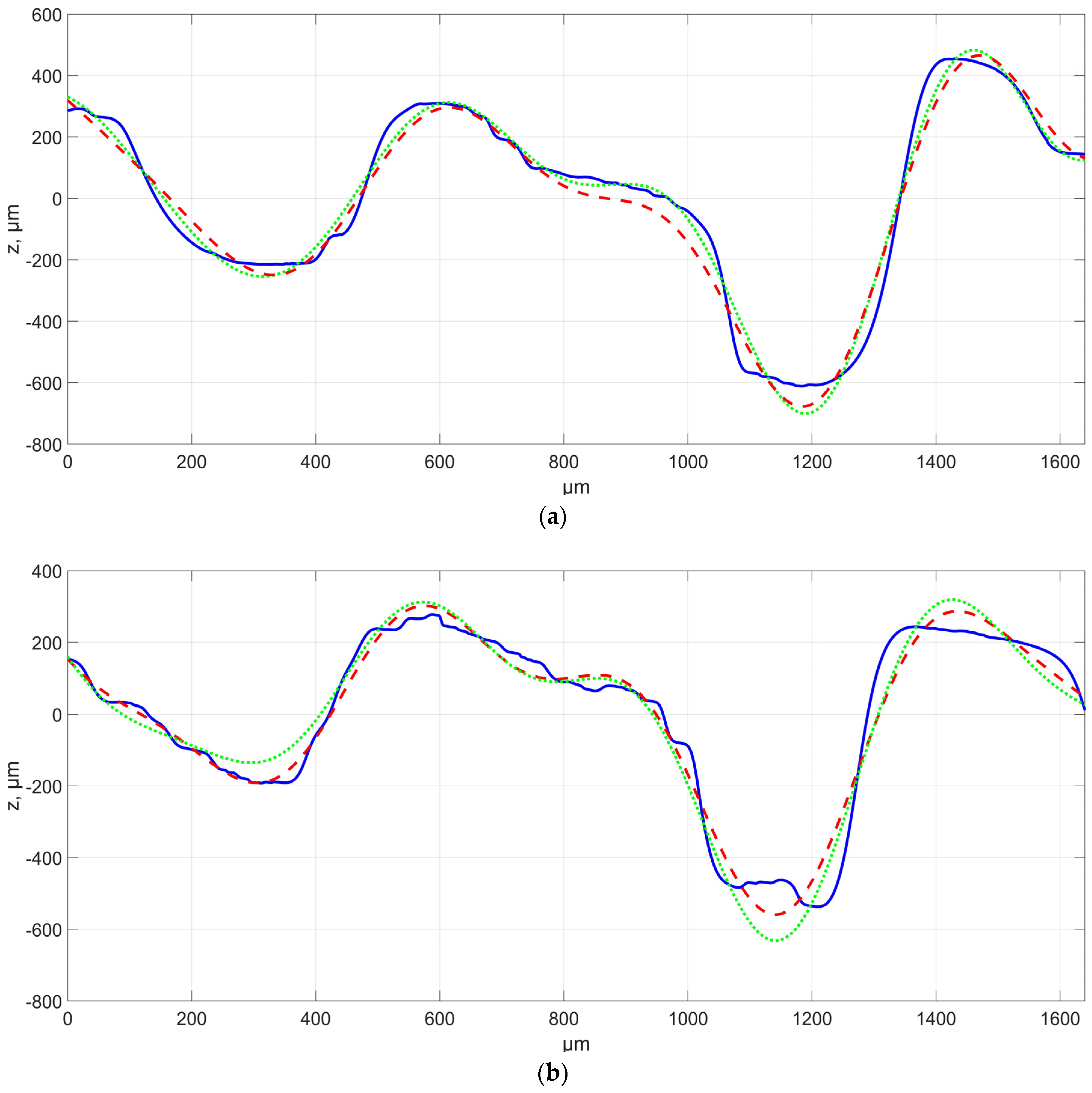
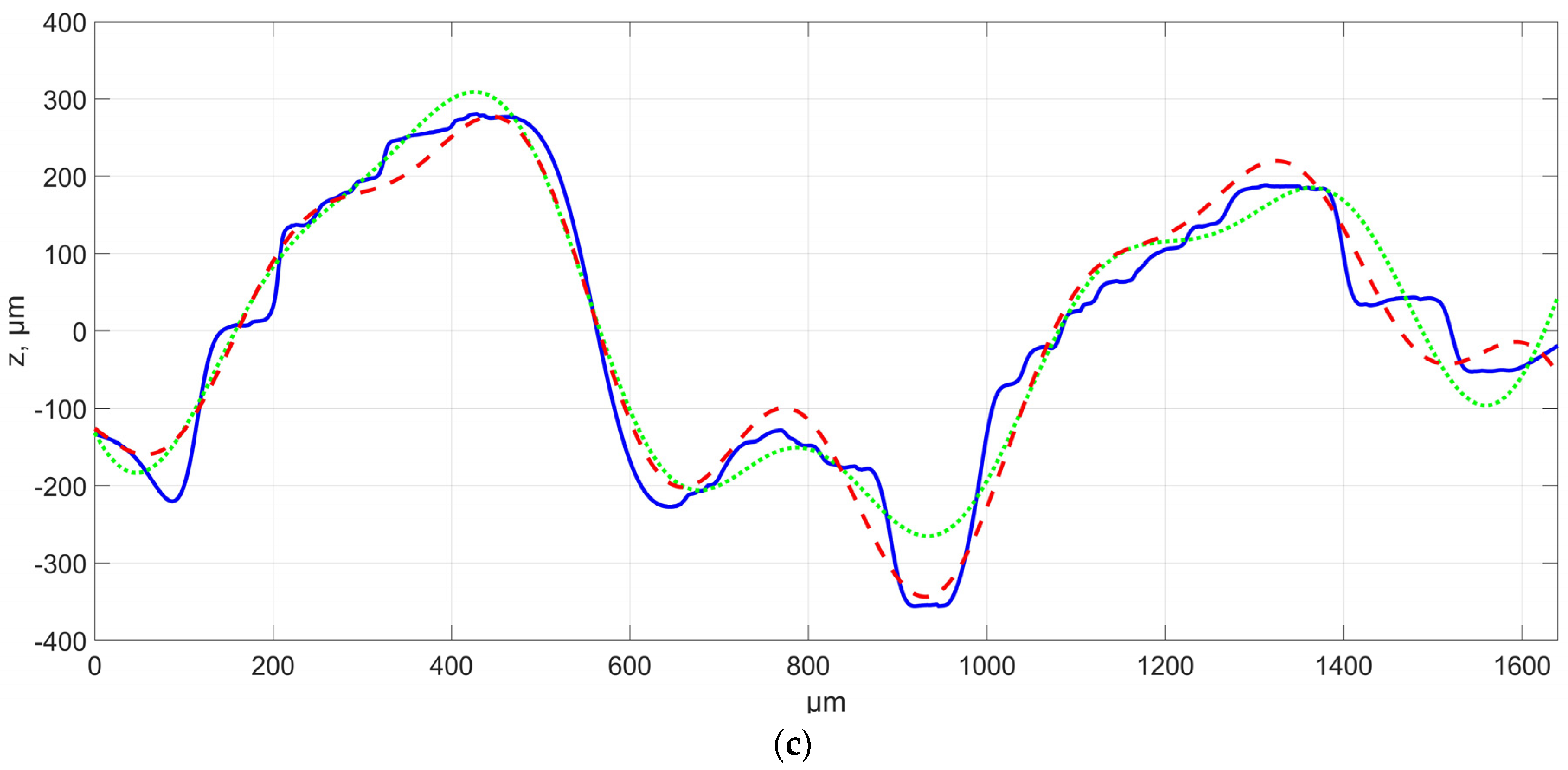
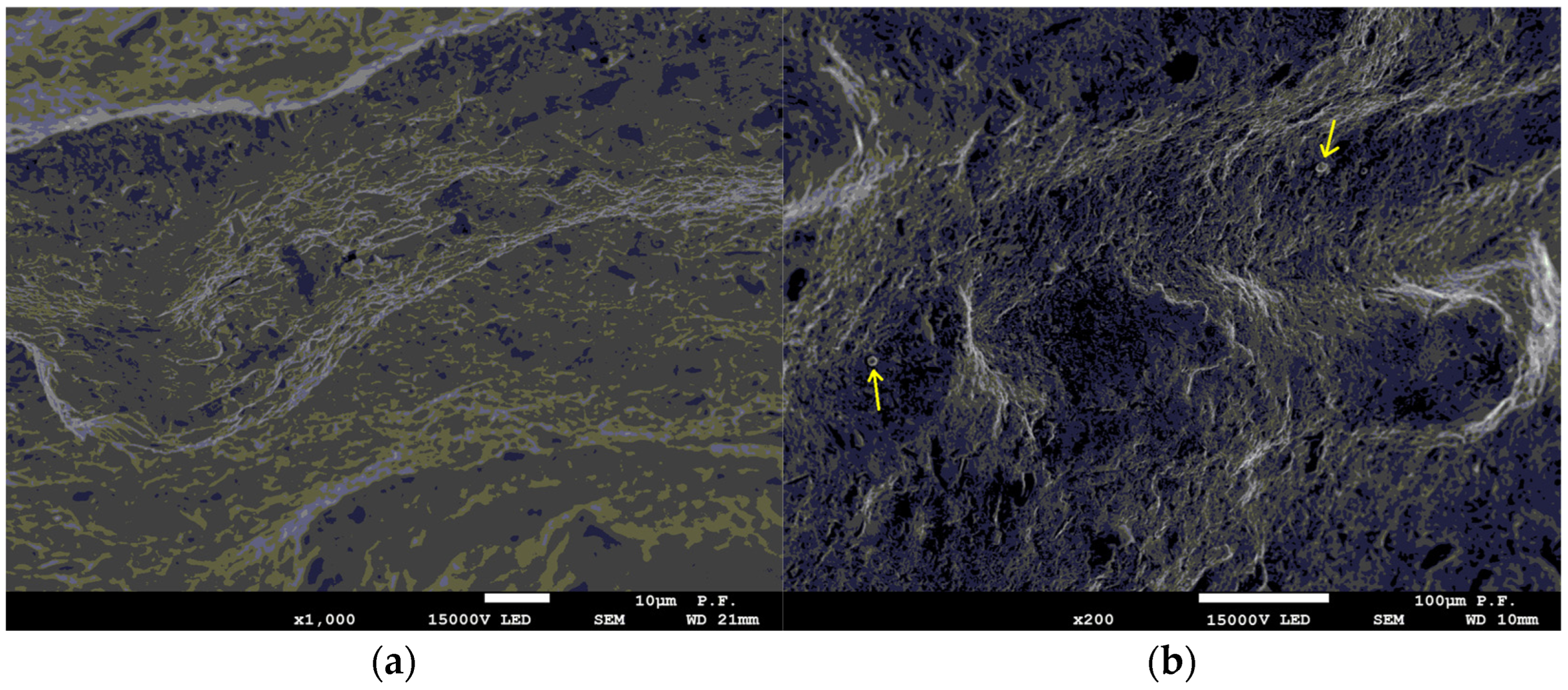

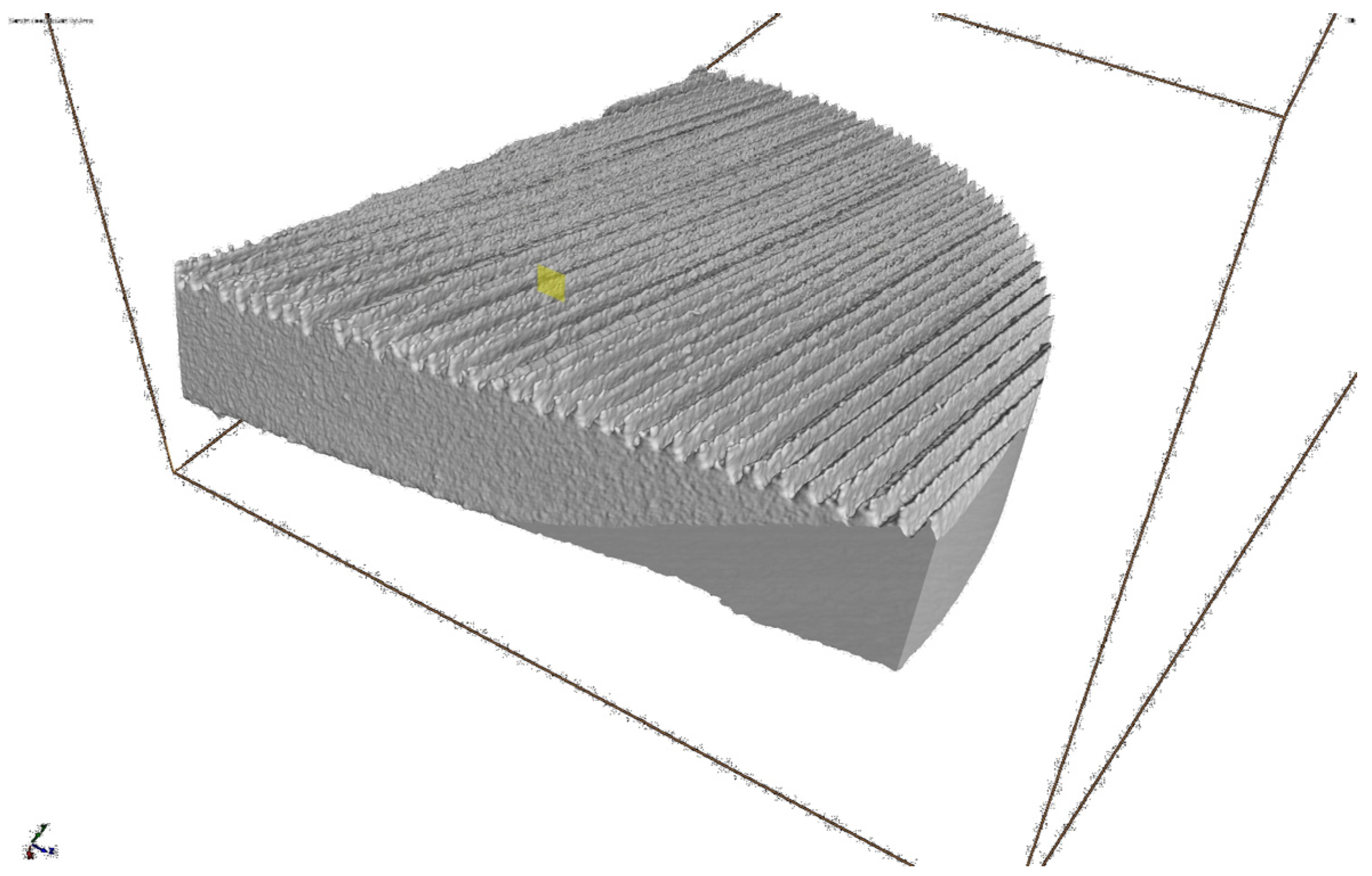
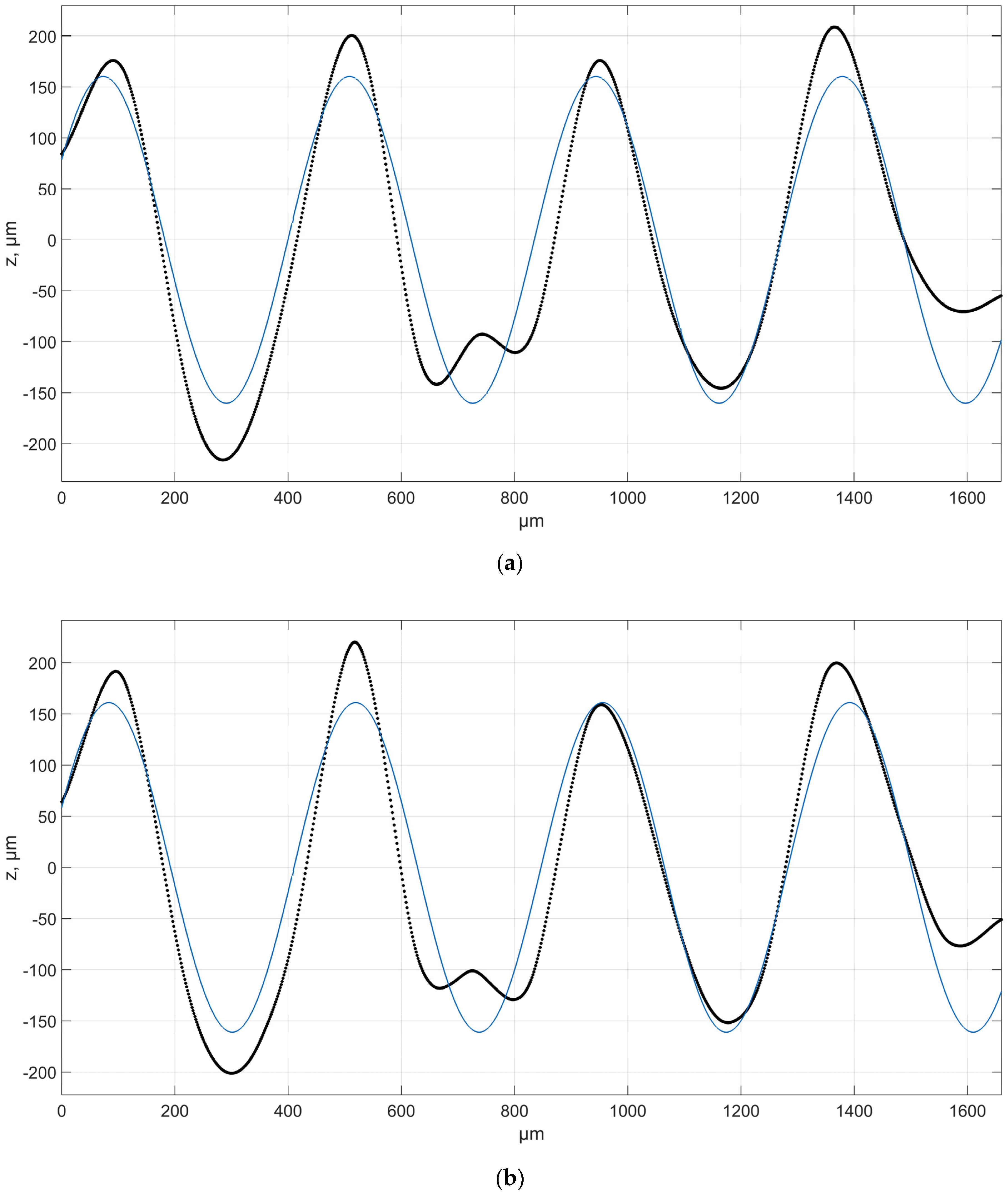

Disclaimer/Publisher’s Note: The statements, opinions and data contained in all publications are solely those of the individual author(s) and contributor(s) and not of MDPI and/or the editor(s). MDPI and/or the editor(s) disclaim responsibility for any injury to people or property resulting from any ideas, methods, instructions or products referred to in the content. |
© 2023 by the authors. Licensee MDPI, Basel, Switzerland. This article is an open access article distributed under the terms and conditions of the Creative Commons Attribution (CC BY) license (https://creativecommons.org/licenses/by/4.0/).
Share and Cite
Gogolewski, D.; Zmarzły, P.; Kozior, T. Multiscale Analysis of Functional Surfaces Produced by L-PBF Additive Technology and Titanium Powder Ti6Al4V. Materials 2023, 16, 3167. https://doi.org/10.3390/ma16083167
Gogolewski D, Zmarzły P, Kozior T. Multiscale Analysis of Functional Surfaces Produced by L-PBF Additive Technology and Titanium Powder Ti6Al4V. Materials. 2023; 16(8):3167. https://doi.org/10.3390/ma16083167
Chicago/Turabian StyleGogolewski, Damian, Paweł Zmarzły, and Tomasz Kozior. 2023. "Multiscale Analysis of Functional Surfaces Produced by L-PBF Additive Technology and Titanium Powder Ti6Al4V" Materials 16, no. 8: 3167. https://doi.org/10.3390/ma16083167
APA StyleGogolewski, D., Zmarzły, P., & Kozior, T. (2023). Multiscale Analysis of Functional Surfaces Produced by L-PBF Additive Technology and Titanium Powder Ti6Al4V. Materials, 16(8), 3167. https://doi.org/10.3390/ma16083167







